Who Is Romain Faivre?
Last season, Romain Faivre (180cm/5’11, 74kg/163lbs) forced French football to stand up and take notice.
The left-footed 23-year-old joined Ligue 1 side Brest last summer from AS Monaco for €400k having previously played just four games for Monaco’s first team – spending the majority of his time at Les Monégasques with Monaco B.
In 2020/21, however, Faivre made 36 Ligue 1 appearances for Les Pirates, scoring six goals and providing five assists, while earning heaps of praise from Ligue 1 watchers as well as his Brest teammates and manager.
Then-Brest boss Olivier Dall’Oglio described Faivre as “a boy with real potential” who possesses “something special” in his game.
Meanwhile, Monaco, Arsenal and Barcelona legend Thierry Henry, who coached Faivre during his stint as Les Monégasques’ manager, shared his admiration for the Brest player earlier this year, saying: “Faivre has something few players have – he breaks lines”.
With all of this in mind, perhaps it’s no surprise that Faivre’s rise to prominence in Ligue 1 outfit Brest has seen him reportedly attract interest from several European clubs of greater stature, including Serie A giants AC Milan, with Faivre said to have been “studied by Milan” as an option for the end of this transfer window.
In this tactical analysis and scout report, we’ll provide analysis of Faivre, highlighting what he brings to Brest and could bring to his new side and their tactics.
We provide analysis of what Faivre is, what he isn’t, why he’s so highly rated, and what his potential new club can expect from him if a move is to transpire in the final days of this transfer window.
What Position Does Romain Faivre Play?
The Brest man is very versatile.
Last season, he played on both the left and right of midfield, as well as central midfield in both deeper and more advanced positions.
Faivre was also utilised as a centre-forward in some games under Dall’Oglio.
However, he is primarily an attacking midfielder and although he’s comfortable on either wing as well as the centre, he was mainly used on the right side of midfield last season.
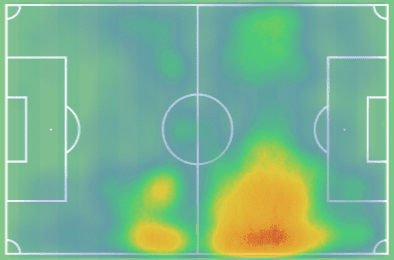
Figure 1 shows Faivre’s heatmap for the 2020/21 campaign, which highlights where the 23-year-old spent the majority of his time on the pitch for Brest last season.
Here, we can see that Faivre was mainly situated out wide on the right, spending a lot of his time on the touchline, while also frequently occupying the right half-space.
Faivre’s versatility is one plausible reason that explains why he’s so highly sought-after at present.
The midfielder is familiar and comfortable with playing all over the pitch and using his skill set to help his side in that role, regardless of exactly which position he’s assigned.
Faivre likes to receive the ball in deeper areas, like the ones highlighted yellow just inside of his own half in figure 1, before carrying it upfield – usually into central positions, but also along the wing on occasion if the space presents itself to progress out wide and it’s too difficult to move through the centre.
Similarly, with his team in possession in more advanced areas, Faivre likes to receive passes out wide – even as far wide as the touchline just inside the final third – before dribbling inwards, taking on opposition defenders with the ultimate goal of getting his team on the ball more centrally, in a more threatening position than the one in which he originally picked up possession.
With this in mind, Faivre could be simply described as a player who receives the ball in relatively non-threatening positions and brings it into more threatening ones, primarily via his carrying ability which he uses to progress before releasing to a well-positioned teammate.
This is what you’re getting in Romain Faivre, it’s a highly desirable quality that makes him an attractive prospective signing for other clubs, as well as a key player for current side Brest.
Romain Faivre Dribbling Abilities
Undoubtedly one of Faivre’s greatest qualities on the pitch is his ball-carrying ability.
The Frenchman is excellent at driving his team upfield via carries.
As mentioned earlier in this tactical analysis piece, Faivre’s former coach Thierry Henry waxed lyrical over the player’s ability to break lines earlier this year.
A lot of the time, players who break lines do so via line-breaking passes – spotting movement from teammates ahead of them, positioned between the lines, and thanks to their vision and technical quality, then picking them out via a line-breaking pass.
Faivre, however, doesn’t actually do this much – instead, he likes to break lines by carrying the ball upfield himself.
Faivre’s team constantly look to the midfielder’s movement and dribbling quality to collect the ball in non-threatening positions in deeper areas of the pitch or out wide, before then carrying it into more threatening areas further up the pitch and/or more centrally, taking on opposition players and beating them with his dribbling skill to break lines and help his team.
Thanks to his important role at Brest in driving his team upfield and breaking lines, last season the 23-year-old stood out for his ball progression abilities as, per Wyscout, he averaged 4.01 progressive runs per 90, ranking him 6th among Ligue 1’s attacking midfielders and wingers to have played at least 800 league minutes – trailing only Neymar, Kylian Mbappé, Hatem Ben Arfa, Moussa Doumbia, and Jérémy Doku in this metric.
Additionally, per FBref, Faivre ranks in the 95th percentile for progressive carrying distance and the 97th percentile for carries into the final third among attacking midfielders and wingers in Europe’s top five leagues over the last calendar year, further highlighting his impressive performance in terms of driving his team upfield and taking them from less threatening positions to more threatening positions.
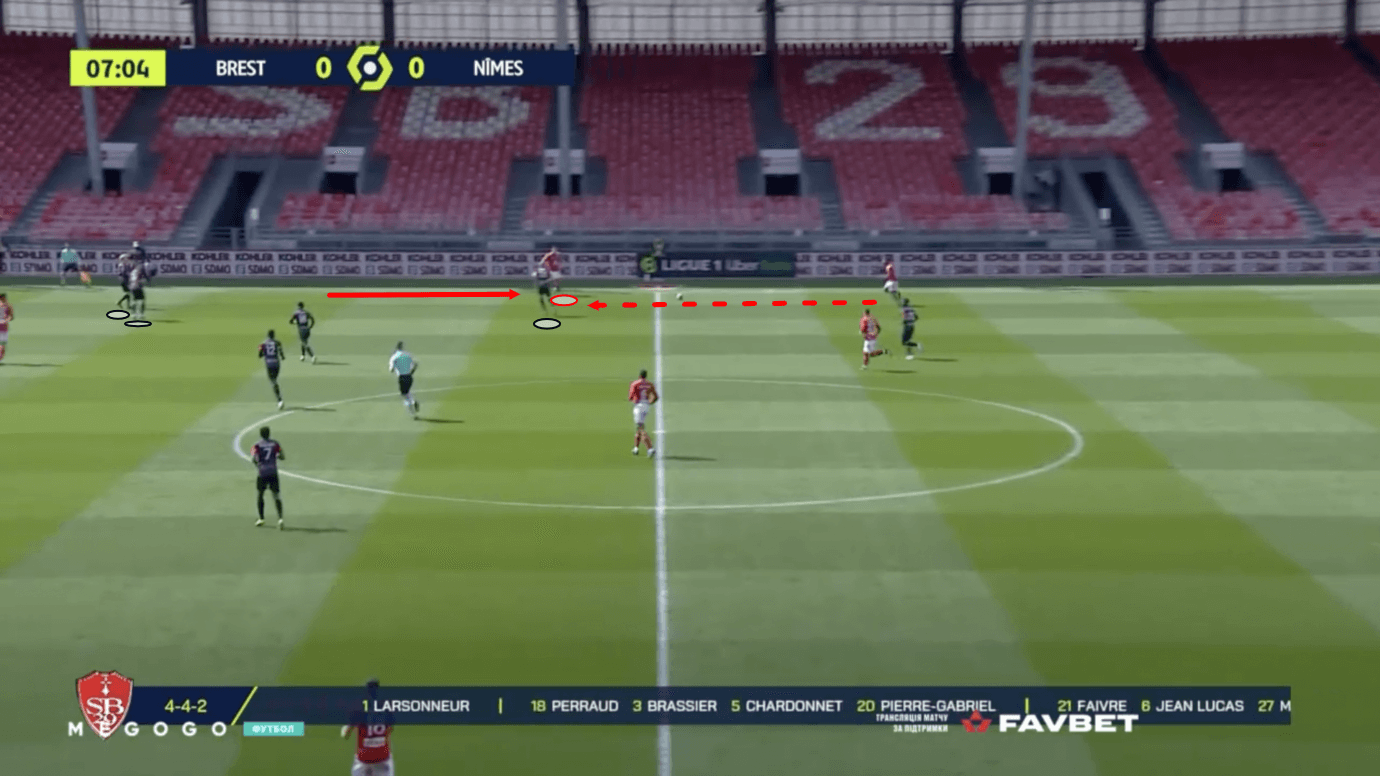
In figure 2, we see an example of Brest playing the ball to Faivre just inside of the opposition’s half, wide on the right-wing – essentially hugging the touchline.
At this moment, not many passing options are presenting themselves to the midfielder – certainly, none that progress the team or put them in a more threatening position, while one opposition player is pressing him close from the inside and two deeper opposition players are positioned closely together on the wing ahead of Faivre.
This is a typical example of the kind of position where Faivre often receives passes for Brest, as Les Pirates look to the 23-year-old to essentially make something happen and get the team’s attack moving.
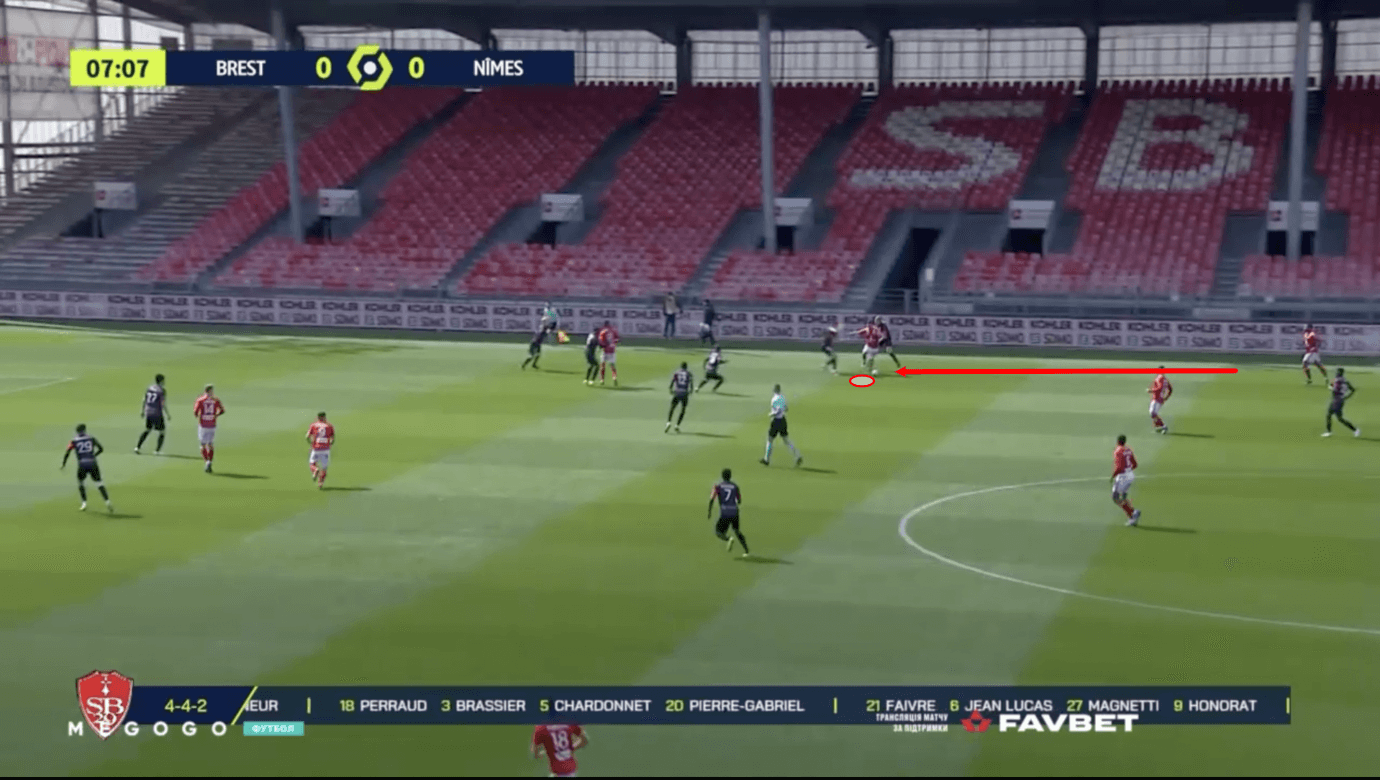
As play moves on into figure 3, we see that after taking the ball on the half-turn, looking up, and starting his drive forward, Faivre began to attract plenty of attention from the aforementioned opposition defenders who are attempting to close down Faivre and put a stop to his progressive run.
Despite attracting very close attention from two opposition players in particular – one of whom Faivre successfully protected the ball from while continuing his run for some distance as he made his way up the wing and the other who can be seen launching into a tackle in figure 3, the midfielder successfully managed to continue his dribble while weaving between the opposition players and began to turn inside, taking the ball into a more advanced and more central area for Brest.
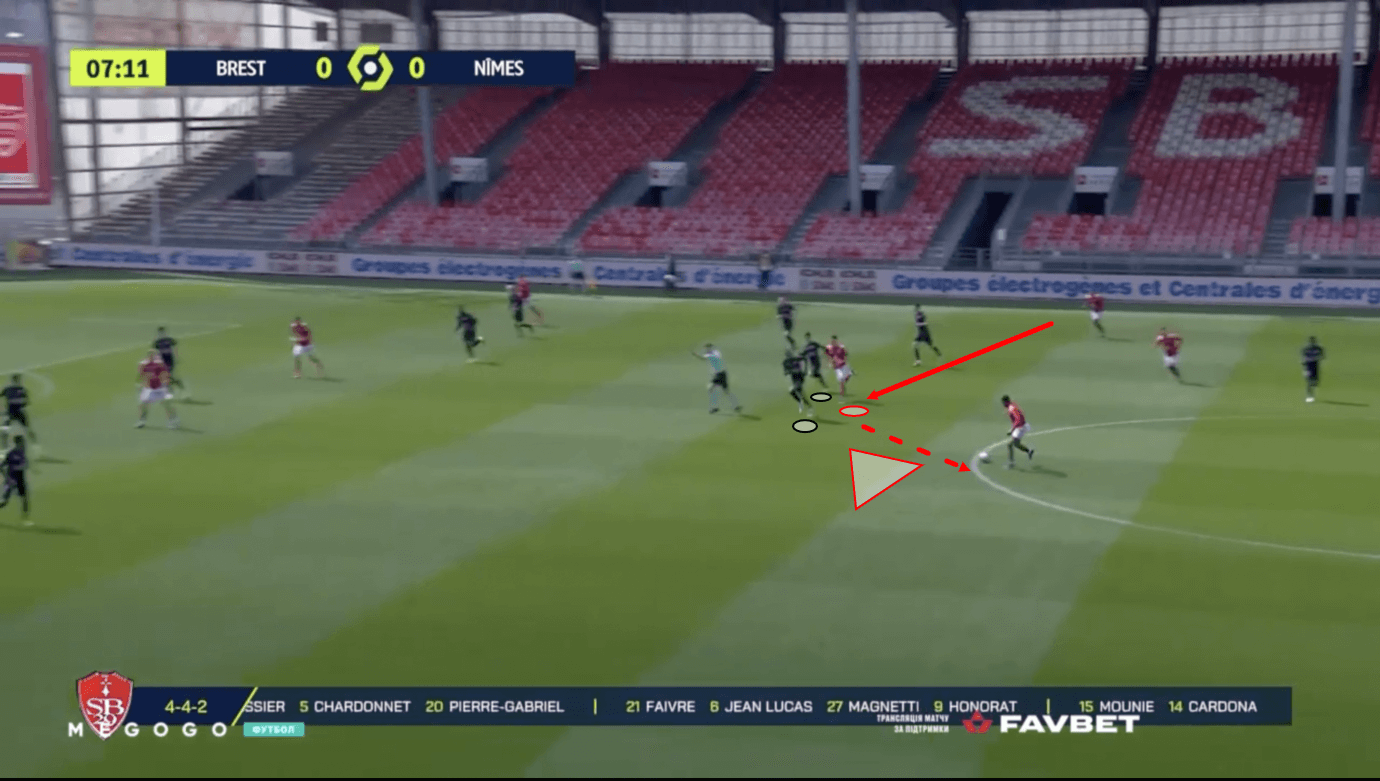
Faivre went on to shake off the two opposition players on his shoulders in figure 3 and as he continued his run, he managed to attract two new opposition players towards him and the right side of the pitch.
Then, in figure 4, we see that the ball carrier eventually released, passing the ball backwards ever so slightly to Brest’s central midfielder who now has an open passing lane into the forward line thanks to Faivre and his ability to attract opposition players towards him.
So, when Faivre picked up the ball back in figure 2, we saw that Brest were positioned wide and just inside the opposition’s half, playing against a well organised and compact mid-block.
When the midfielder ultimately released the ball, we see that they’re positioned slightly further up the pitch, a lot more centrally, with the opposition’s shape completely disrupted and a passing lane into the forward line wide open.
On paper, Faivre can appear to be a very safe passer.
His pass accuracy rate for last season was 84.6% – which is quite high, ranking him 22nd out of all attacking midfielders to have played at least 800 minutes in Ligue 1 last season (over 150).
He isn’t a massive risk-taker with his passes and doesn’t often break lines with passing.
He frequently plays safer passes like the one seen in figure 4 or little, close one-twos to quickly link up with a teammate before progressing upfield with a run.
However, he passes intelligently and with purpose, and when looking at his passing tendencies within context, it paints a picture of a player who is constantly improving his team’s positioning, primarily via his risk-taking progressive runs, before then playing a safer pass while under pressure, as he’s created that luxury for himself through the initial run.
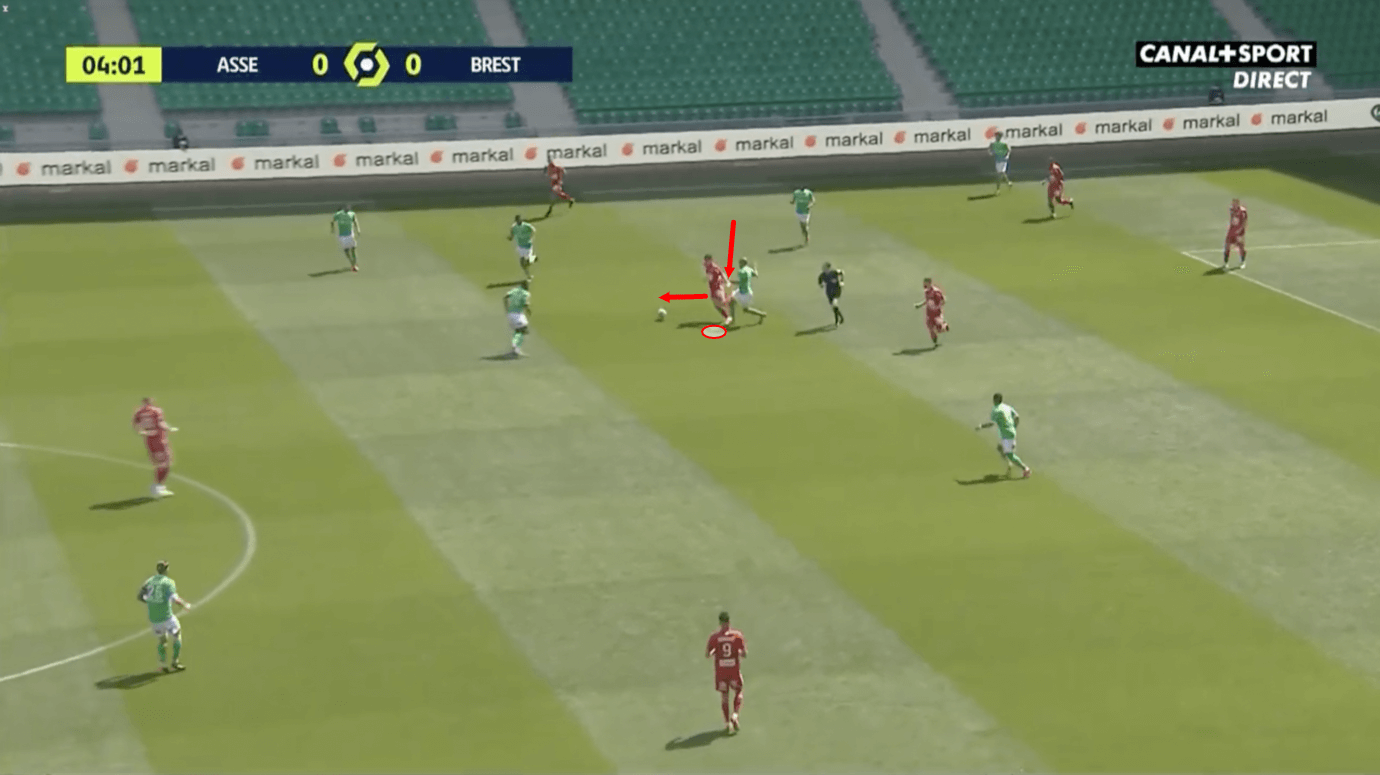
In figure 5, we see an example of an occasion where Faivre received a pass deep on the wing in his own half before setting off on his run – this time, immediately taking the ball centrally and attracting pressure in the process.
This is an example of Brest using Faivre’s ball-carrying quality to kickstart a counter-attack.
The 23-year-old’s ball-carrying ability is an excellent weapon for his side on the counter, as Faivre loves to drive his team upfield and Brest can rely on the midfielder to take them into threatening positions on the counter safely.
Faivre’s counter-attack threat is another reason for his rise in demand.
However, this image provides an example of another valuable quality within Faivre’s game too – his ability to draw fouls at a high frequency.
The Frenchman ranks in the 79th percentile for fouls drawn among top five league attacking midfielders and wingers over the last year, and frequently helped his side to improve their in-game situation via his foul-winning ability, resulting from his ball-carrying quality.
In figure 5, as Faivre attracted attention from the tackling player while dribbling, he intelligently baited the opposition player into committing to a tackle before sharply switching direction, leaving a trailing leg out, and drawing the foul.
Faivre is very good at winning fouls like this.
Love it or hate it, this is an art form that can help teams win games and the Brest man is very good at it.
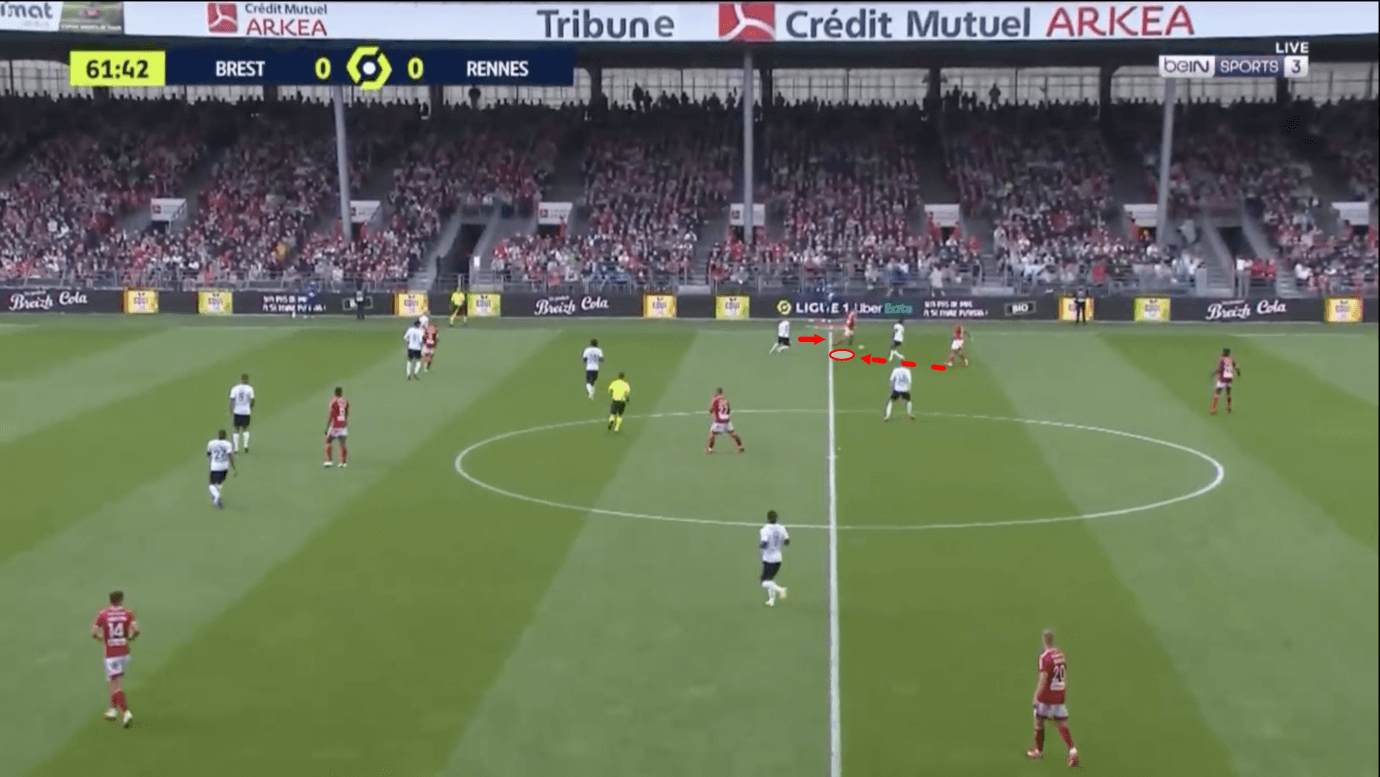
In figure 6, we see a sight that’s becoming a familiar one – Faivre picking up the ball deep.
As he received the ball, he took a heavy touch and moved backwards, creating a tiny bit of separation between him and the opposition player following so that he could then turn relatively uninhibited to begin moving forward – an example of some of the intelligent movement that Faivre’s capable of making.
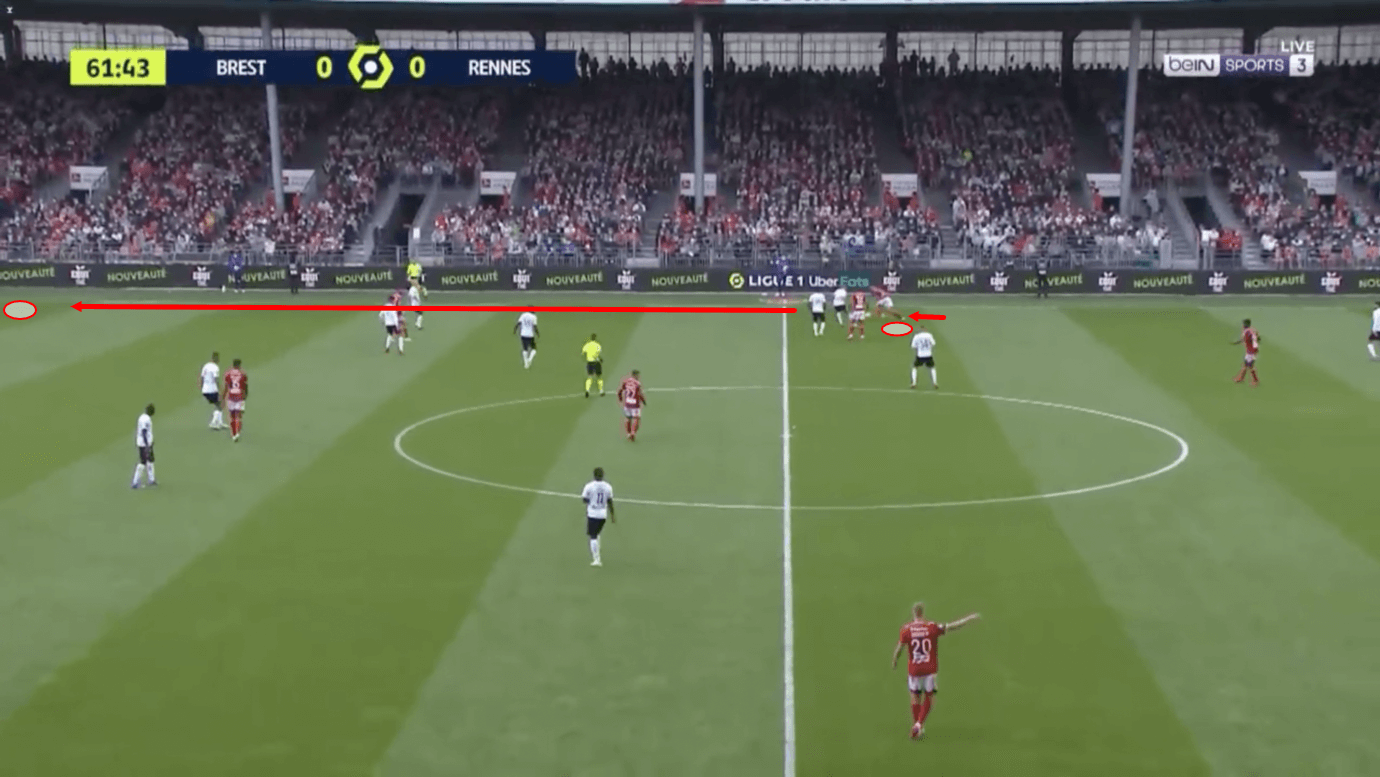
After turning, Faivre knocked the ball down the wing, past the player who was marking him, and proceeded to dribble all the way down to the far more advanced position circled in figure 7 – beating another opposition defender along the way to do so.
Once there, Faivre used his skilful, quick feet and dribbling quality to draw a foul out of an opposition player on the wing before he could carry the ball into a more central position, winning his side a free-kick quite high up the pitch – putting Brest in a far more threatening position than they were in when the 23-year-old initially received possession.
Again, this highlights how Faivre’s dribbling quality can benefit his side in terms of progression and combine with his intelligent ability to win fouls, to then create favourable attacking situations.
As well as ball progression, Faivre performed as a standout in terms of shot-creating actions last season.
Over the last calendar year, the 23-year-old has made 4.63 shot-creating actions per 90, ranking him in the 90th percentile for this metric amongst attacking midfielders and wingers from Europe’s top five leagues.
Shot-creating actions are defined as the two offensive actions directly leading to a shot, such as passes, dribbles, and drawing fouls.
We already know that Faivre is a threatening dribbler, regularly putting his team in far more favourable positions via his carrying and subsequent intelligent passing, while he also has great ability to win fouls.
His impressive performance in shot-creating actions highlights how his ability to put his team in more threatening positions directly creates shooting opportunities regularly – highlighting the value of his qualities in a creative context.
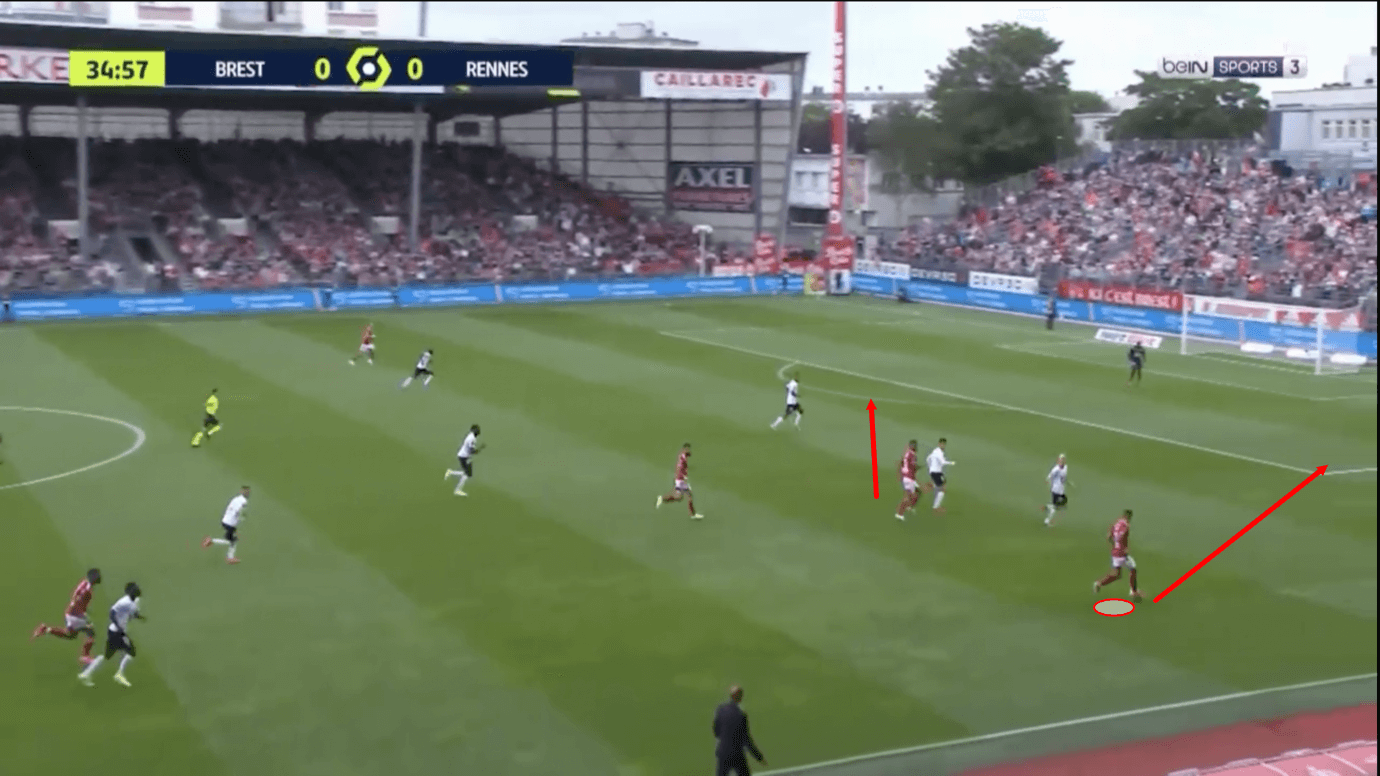
In figure 8, we see an example of Faivre picking up the ball wide on the right-wing, just inside the final third.
The Brest man is comfortable with providing the width for his side inside the final third, receiving in positions like this one or wider before carrying the ball inside, taking opposition defenders out of the game as they approach to tackle him, thus creating dangerous attacking situations.
Faivre played just 1.22 crosses per 90 last season in Ligue 1 – a relatively low number for an attacking midfielder/winger in the league and highlighting that while he likes to occupy this wide position inside the final third, he doesn’t play a lot of crosses from here and does generally rely more on his dribbling quality to make his way inside or quick, little bits of link-up play with teammates in these attacking areas.
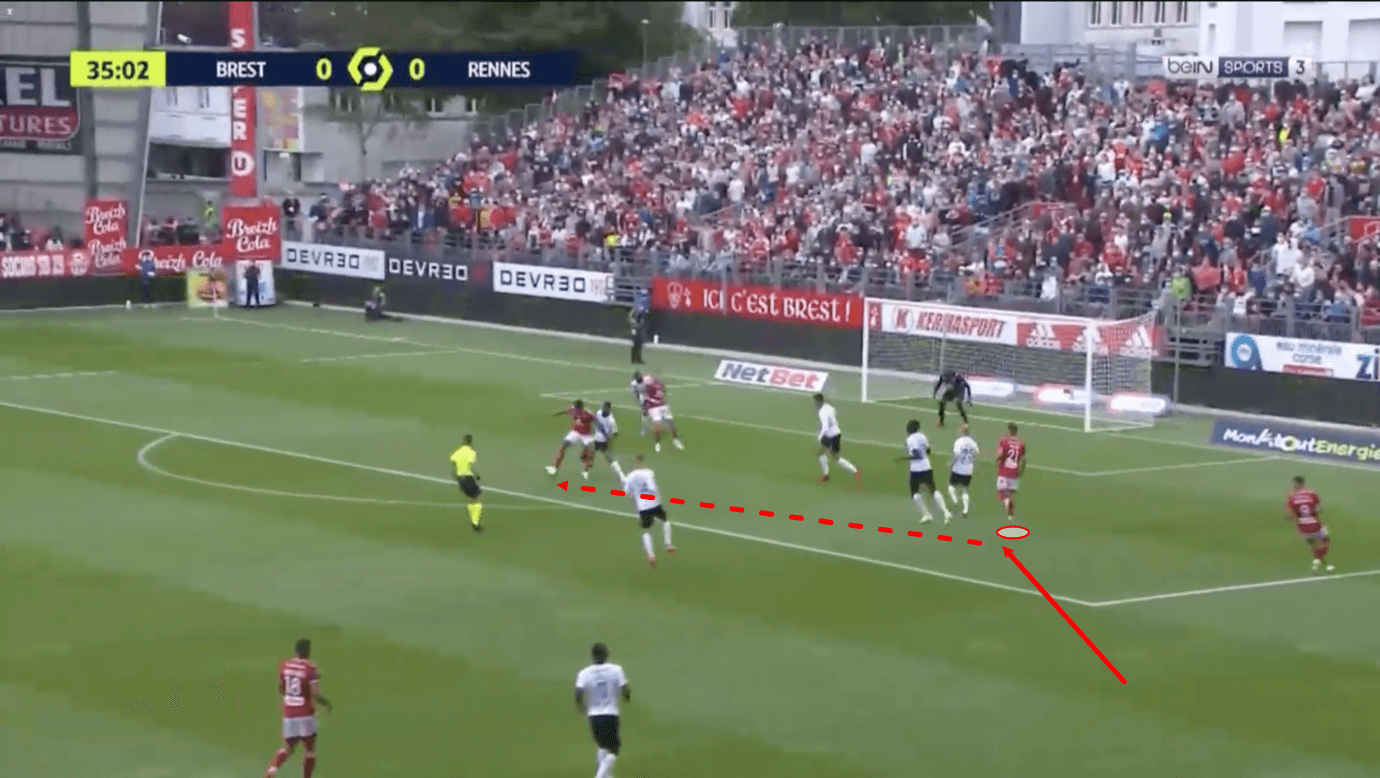
On this particular occasion, Faivre relied on his dribbling quality.
He drew the opposition left-back to him and took that player on 1v1, beating him with little trouble and as play moves on into figure 9, we see that the midfielder made it all the way into the opposition’s penalty area, where he managed to cut the ball onto his left foot and play it across the box into Brest’s centre-forward who could hold up the ball centrally while waiting for a teammate to arrive from a deeper position before shooting.
This passage of play highlights Faivre’s value in the final third, again, in terms of improving his team’s positioning, increasing their threat, and doing a lot to directly contribute to a shot.
Faivre is constantly picking the ball up in deeper and/or wider positions, carrying it into more advanced and central positions to improve their positioning and likelihood of scoring – that’s what he does and can bring to his team.
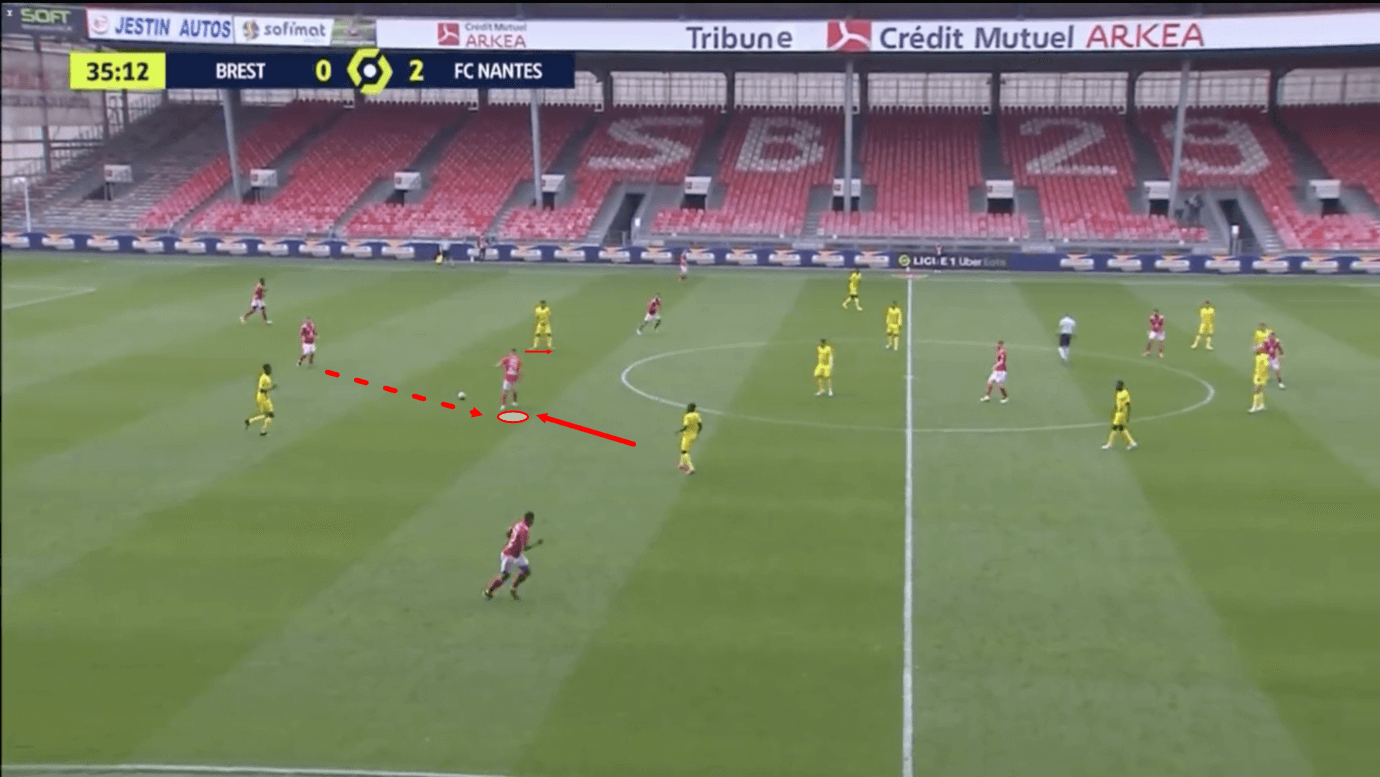
As mentioned at the beginning of this scout report, Faivre is very versatile.
The previous in-game examples we’ve analysed showed Faivre playing on the right wing which, as mentioned, was his primary position with Brest last season.
However, he also played in central midfield at times last term, an example of which can be seen in figure 10.
Here, we see Faivre receiving the ball from his teammate at centre-back while turning to face the opposition’s goal.
The Frenchman is reliable in these situations because of his constant intelligent scanning.
He makes sure to be well aware of his surroundings when receiving the ball in these areas, and he can take the ball well on the half-turn like in the image above.
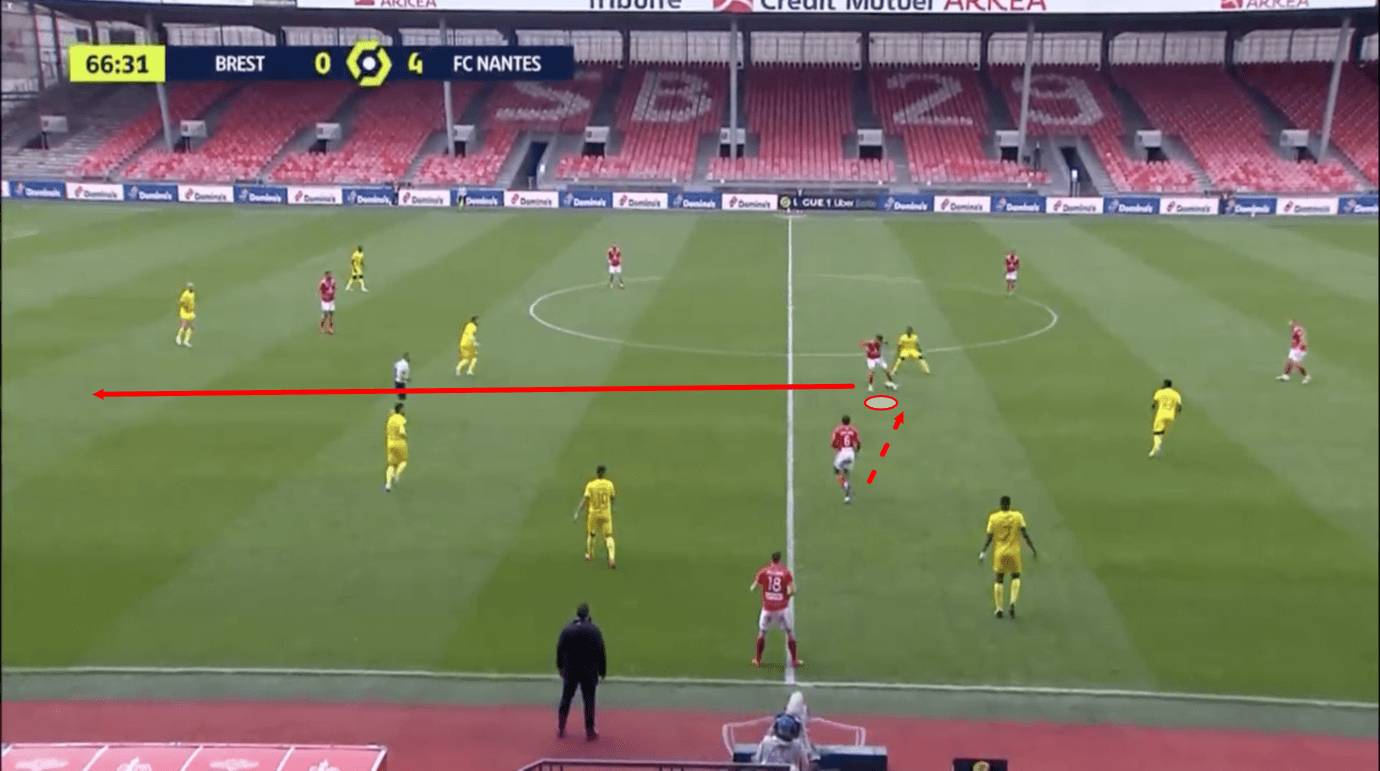
Additionally, Faivre is good at disguising his intentions and manipulating the opposition, especially his marker, when receiving the ball, which is particularly evident when playing centrally.
In figure 11, we see another instance of the Frenchman receiving a pass in central midfield to his back leg.
While receiving the pass, he leans onto the back leg in such a way that it looks like he intends to turn out this way, which leads to the opposition player marking him to cover this area and brace for him to turn out.
However, as play moves on, we see Faivre quickly change direction by knocking the ball into the opposition half, in front of where his right leg is placed in this image.
This short example highlights Faivre’s intelligent movement and ability to disguise his intentions when receiving the ball via subtle turns and body placement.
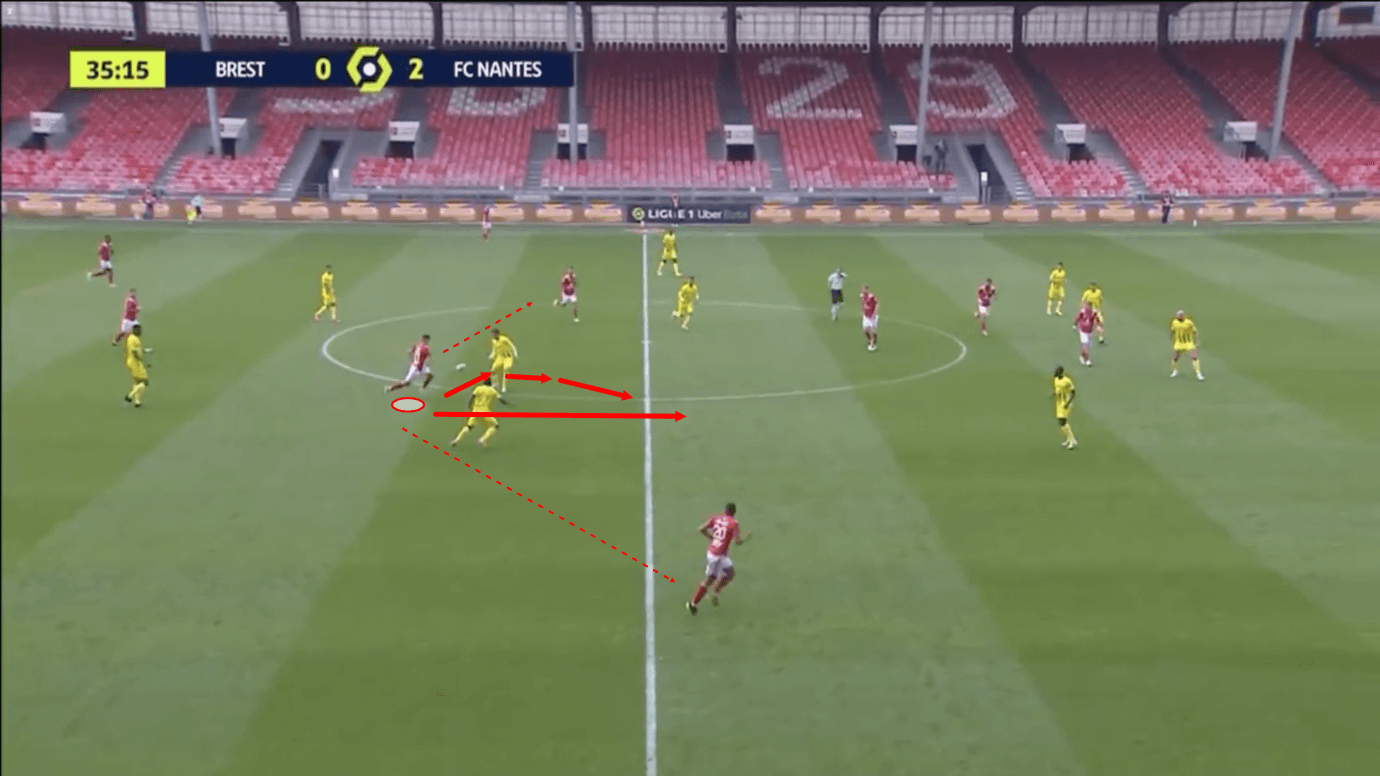
As the passage of play in figure 10 moves on into figure 12, we see that as Faivre turned, he attracted pressure from the opposition’s left midfielder and left central midfielder.
This left teammates in space to his left and right, who are options that midfielders in this position would often take and pass to.
Instead, though, Faivre only had eyes for one option – carrying the ball upfield by dribbling through the two pressing players.
As the two opposition players closed him down, Faivre neatly clipped the ball forward between them and ran straight through the two men to get onto the end of that clipped ball and break the opposition’s midfield line, which would have created an overload for his team versus the opposition’s backline and put Brest in a very threatening position.
However, as the play moves on, we see that Faivre actually gets fouled as soon as he enters the opposition’s half, which wins his side a free-kick in this area, again highlighting his ability to draw fouls in dangerous positions while progressing play.
Faivre does well to create an unpleasant conundrum for the opposition – either foul him to give away a free-kick or don’t foul him and let him carry the ball into a dangerous position.
Romain Faivre Movement and scanning
Faivre’s off-the-ball movement before receiving a pass is generally another strength to his game.
Firstly, Faivre is very intelligent and diligent with his scanning.
He’s excellent at observing his surroundings and creating a picture of the game around him in his head before receiving the ball to be able to make quicker, better-informed decisions when he does receive a pass.
While scanning, Faivre adjusts his positioning to find space he can exploit, and he picks out teammates with whom he can link up on receiving possession.
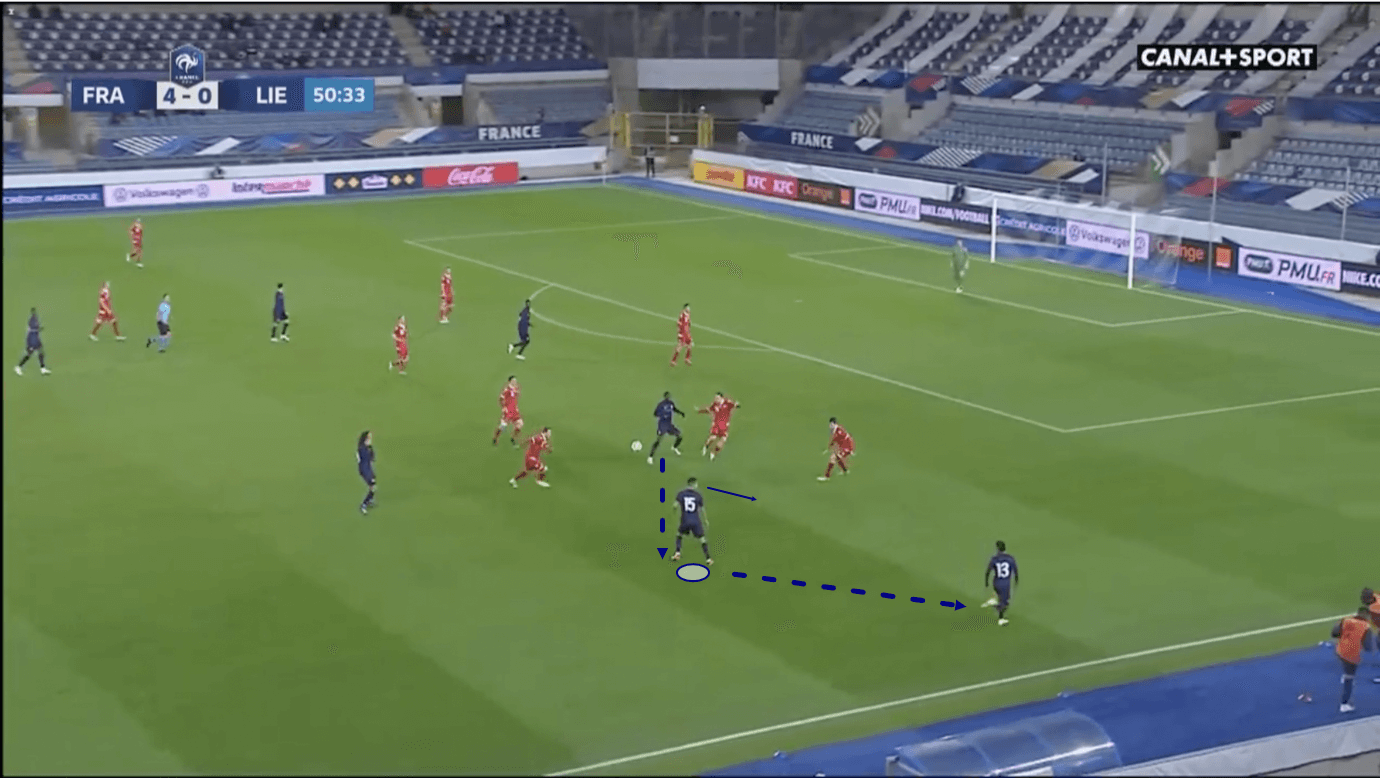
The passage of play beginning with figure 13 shows an excellent example of Faivre’s scanning and movement, with this example taking place inside the final third.
In figure 13, we see Faivre positioned on the right wing, receiving a pass from a teammate in the right half-space.
Before this image, Faivre scanned multiple times and jogged backwards to increase space between himself and the ball carrier.
By doing so, he was able to exploit space on receiving this pass better than if he were positioned closer to the passer who has attracted several opposition players towards him.
Faivre has an excellent understanding of space.
It’s common to see him make smart decisions like this, in terms of increasing distance to help his teammate and improve his positioning, while scanning and absorbing all of the information around him.
Additionally, while receiving this pass, Faivre spotted a teammate overlapping on the wing, who he quickly opted to pass to on receiving the ball, helping his side to stretch the opposition and their defensive shape as a result.
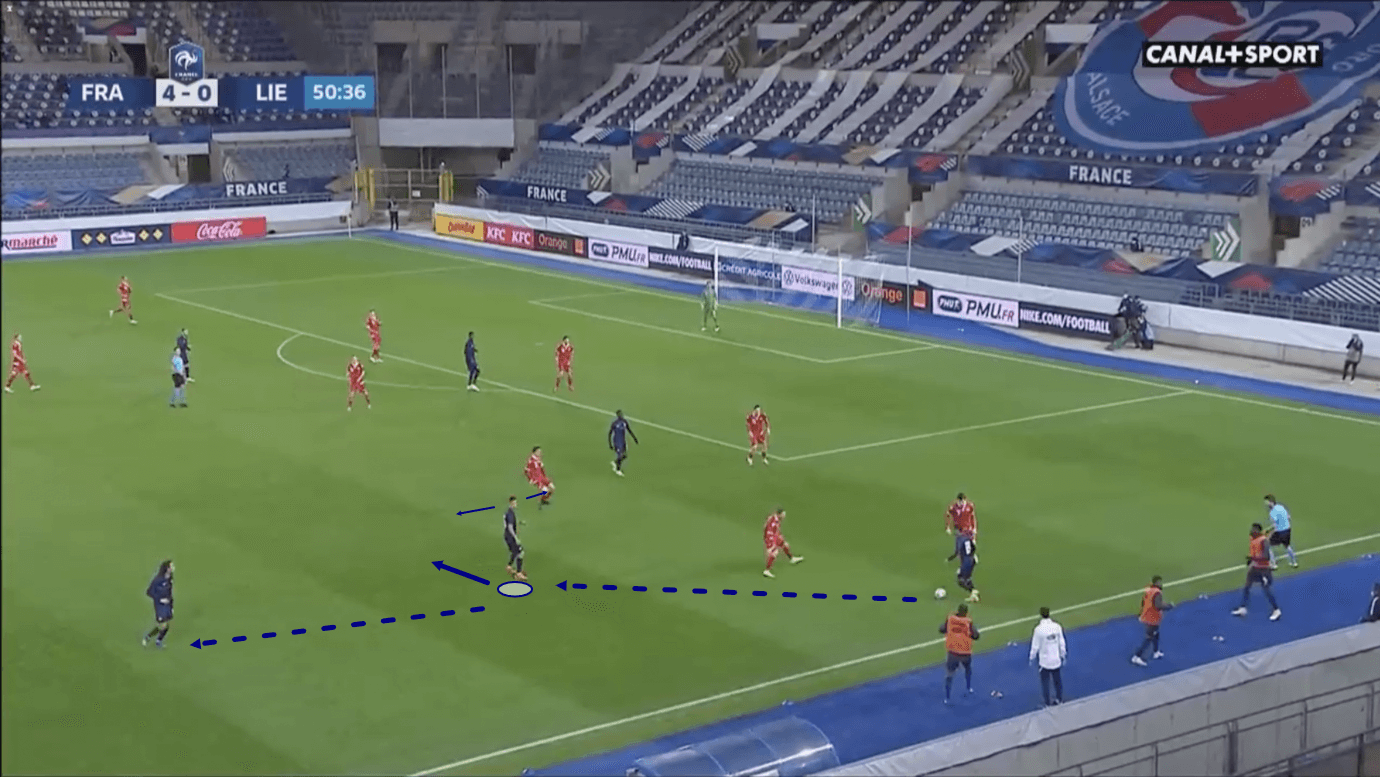
As the opposition react to the ball moving out wide by repositioning and closing the space around the new ball carrier, Faivre continues to scan and opens up his body to give the wide man a passing option while backtracking slightly to increase the distance and exploit the space being created by the wide man and his overlap.
As play moves on into figure 14, we see Faivre receive the ball again before passing back to the slightly deeper teammate positioned just behind him who he spotted while scanning in figure 14.
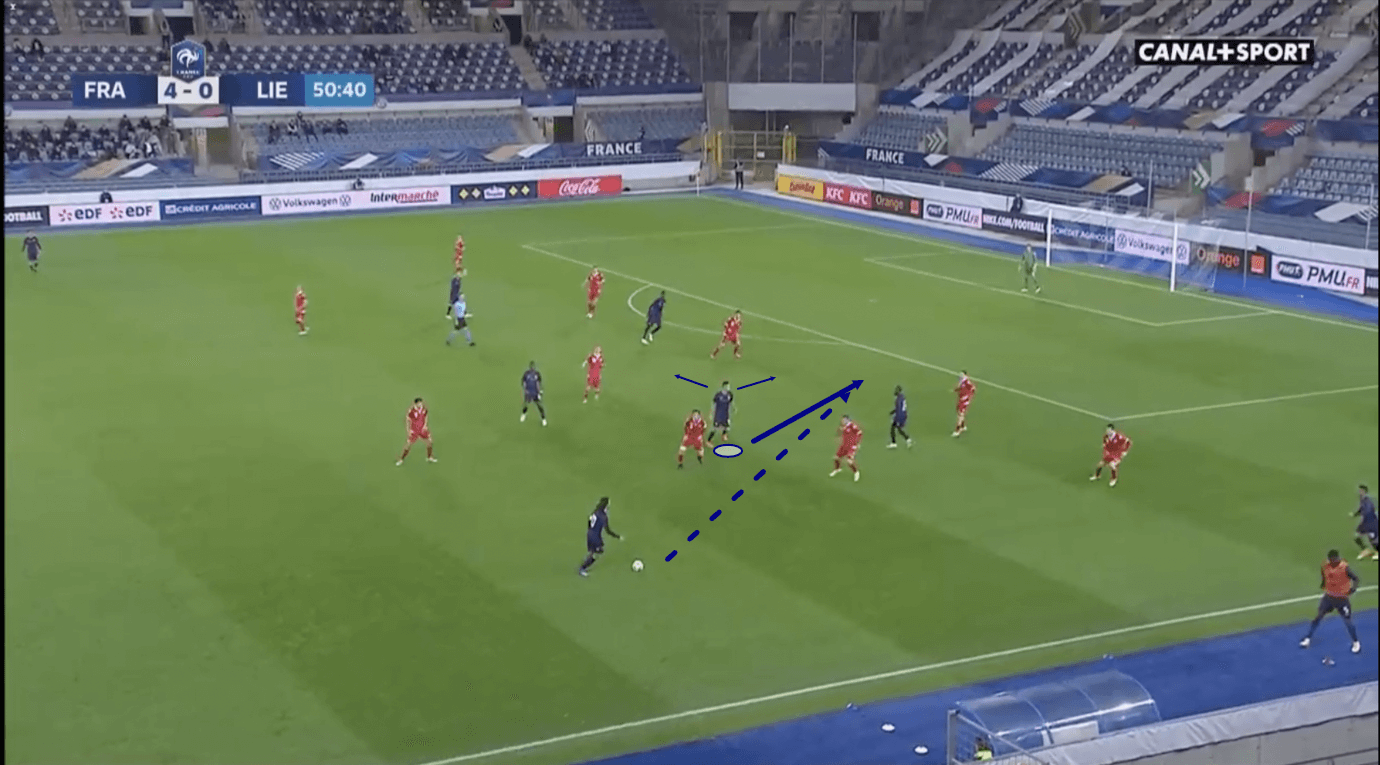
When this deeper player received possession, the opposition had to push up slightly as the midfielders pressed to begin closing him down.
While they did so, Faivre was able to drop in between the lines.
As he continued scanning, which we see in figure 15, he spotted a large gap in the opposition’s backline between the central centre-back and left centre-back which initially opened when the French midfielder played the ball out wide to stretch the opposition.
Now, with the opposition stretched horizontally and starting to stretch vertically, through his scanning, Faivre spotted an opportunity to exploit this space in the backline via a run, making himself available for the deeper teammate on the ball to pick out with a through pass, which he ultimately does.
This passage of play highlights how Faivre’s intelligent scanning, movement, and good understanding of space can help his team to pull the opposition apart.
Here, Faivre played a key role in stretching the opposition out wide and then pulling them forward to create gaps in their defensive structure which he could then exploit via movement.
This shows how useful and dangerous he can be when linking up with teammates in the final third.
He is a great asset in counter-attacks, as observed in the previous section, but also in positional attacks when playing against an organised defensive structure, which this passage of play shows.
Faivre likes to play quick short passes to help break down the opposition and is good at reacting to the opposition’s change in shape and positioning through his movement to exploit space.
He frequently increases space between himself and teammates to make himself a better option and loves to drop into spaces opening between opposition defensive lines to help his team progress attacks.
Romain Faivre Defending Abilities
Faivre is very active defensively.
He offers a lot to his side without the ball and he’s good at helping them to regain possession.
Amongst attacking midfielders and wingers from Europe’s top five leagues over the past year, Faivre ranks in the 90th percentile for tackles, the 96th percentile for tackles won, the 83rd percentile for successful pressures, the 96th percentile for successful pressure percentage, and the 87th percentile for tackles and interceptions.
These numbers paint a pretty impressive picture of the Brest midfielder defensively, highlighting his work rate out of possession as well as his technical defensive quality to help his side win the ball.
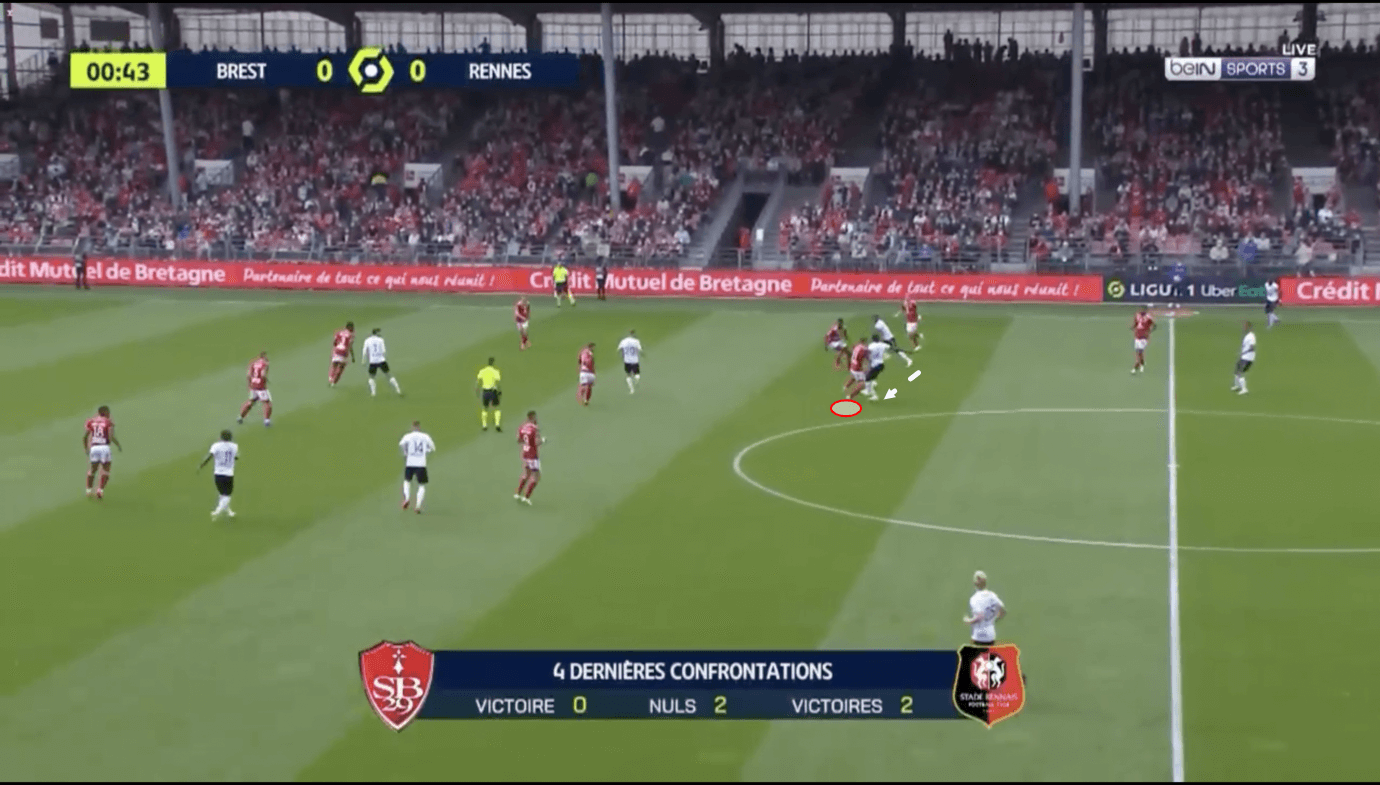
Figure 16 shows an example of Faivre marking an opposition player while occupying the ‘number 10’ position.
Despite Faivre’s presence, the opposition tried to play through this holding midfield player.
As the ball was played into him, Faivre jumped into action and took the chance to make a tackle, halting the opposition player in his tracks and regaining possession for Brest, earning his team an opportunity to start a counter-attack from a dangerous position, against a heavily disorganised opposition.
This example highlights Faivre’s marking ability, as well as his technical tackling ability.
The 23-year-old has good concentration off the ball, defends diligently and ensures that the opposition doesn’t progress through his man with his marking ability and tackling ability.
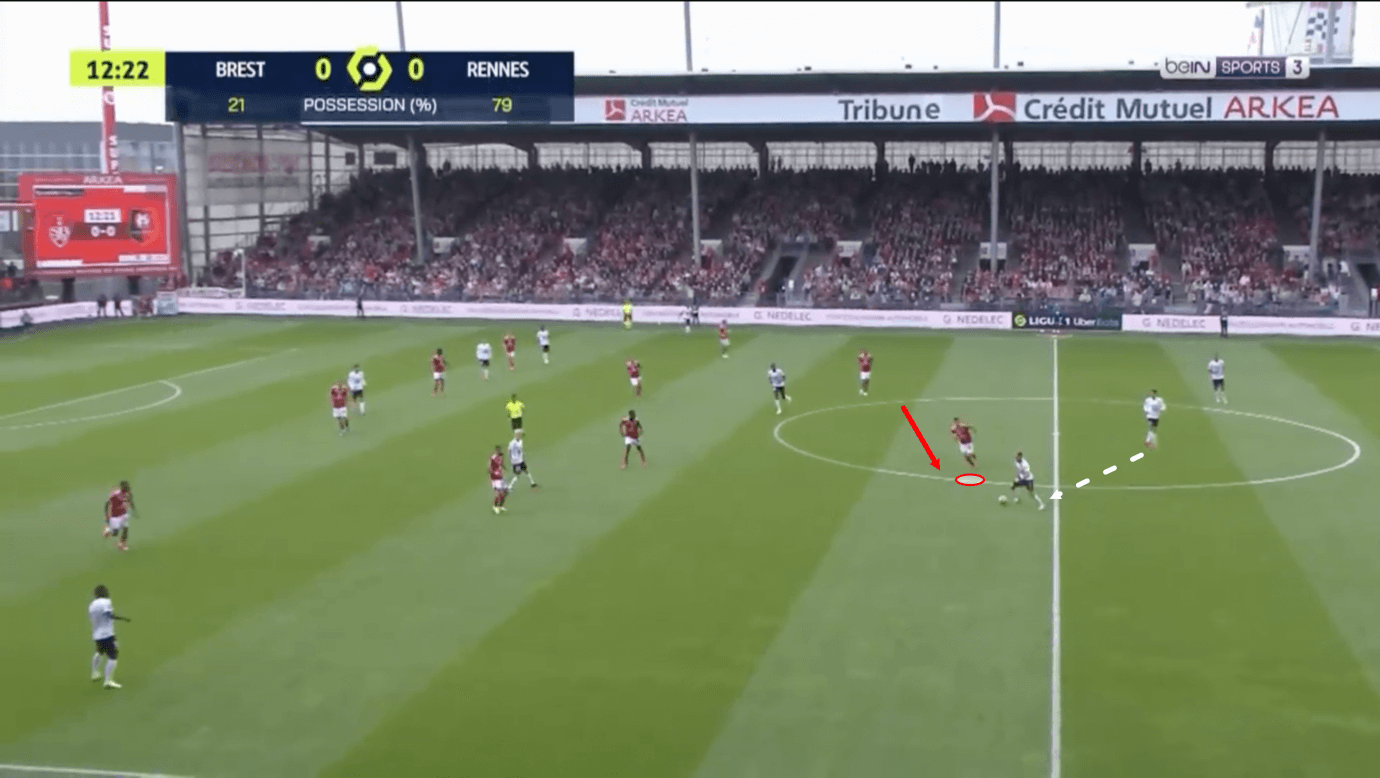
Faivre is also very active in applying pressure to the opposition from the front, which we see an example of in figure 17.
As this player deep on the left of the opposition’s build-up receives possession and begins progressing forward, Faivre reacts by jumping into action and closing the ball carrier down.
While pressing, the 23-year-old remains aware of his surroundings and intelligently keeps the opposition’s right central midfielder in his cover shadow, ensuring that his decision to press doesn’t create a gap for the opposition to easily play through Brest’s defensive structure.
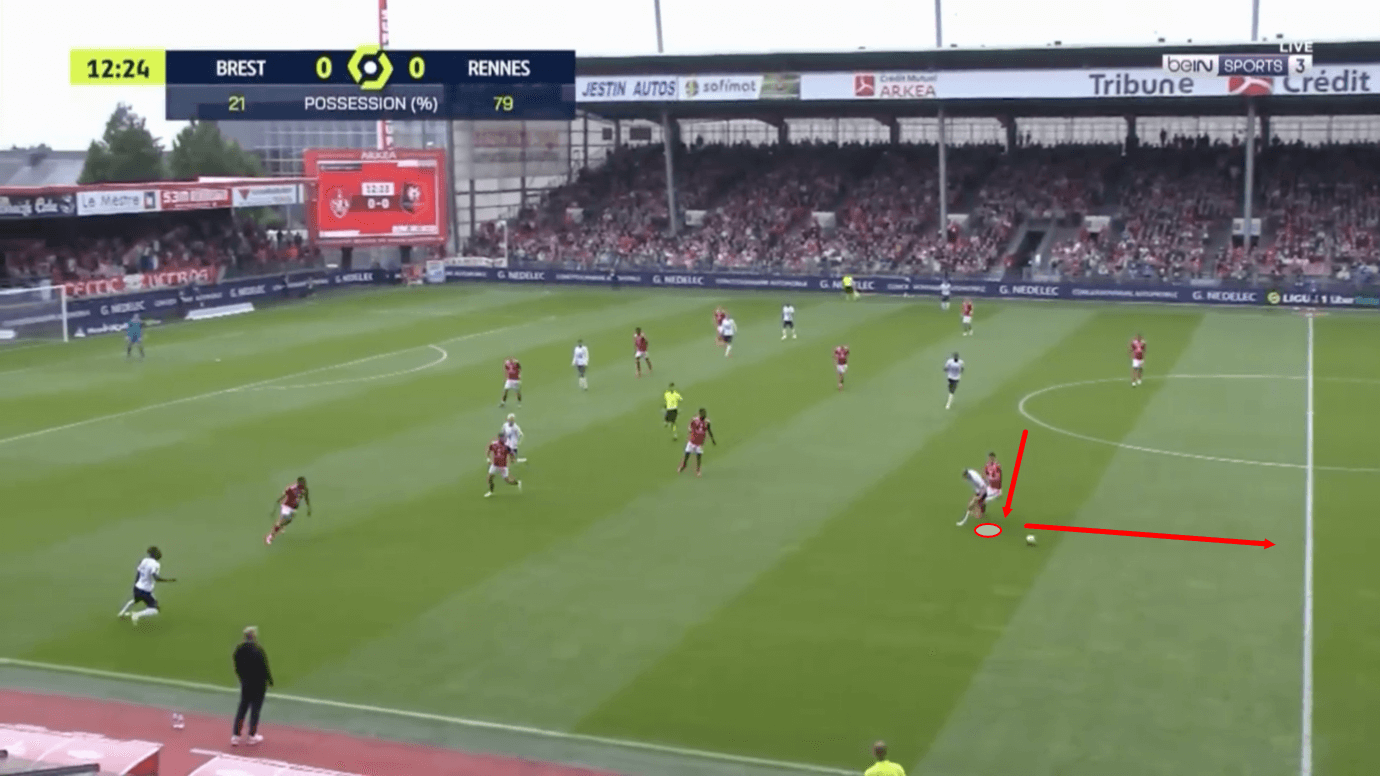
Faivre’s press and intelligent cover shadow usage forces the opposition ball carrier to move wider and away from the more threatening central areas, which we see in figure 18.
As he moved wider, the opposition player still had no clear options, however, as Faivre forced him into an area where Brest had an overload.
Before very long at all, Faivre created an opportunity to tackle the ball carrier and he successfully regained possession just inside of Brest’s half, creating a very dangerous counter-attacking situation for Brest where they could overload the opposition’s backline by counter-attacking quickly.
This passage of play highlights Faivre’s pressing quality.
The midfielder is active in the press and technically good in defensive situations to win possession for his side.
This makes him a defensive asset as well as an offensive one who can set his team up for dangerous counter-attacking opportunities.
Conclusion
To conclude this tactical analysis and scout report, we feel Faivre’s main strengths lie in his dribbling ability – which he and his team frequently use to break lines and progress upfield, with Faivre constantly putting his team into more threatening positions – his off-the-ball movement, frequent scanning, defensive work rate and technical defensive ability.
Faivre could make more threatening passes but he largely makes up for this via his carrying ability, while he could also improve his finishing ability.
Last season he scored six goals from 7.4 xG, which isn’t terrible but does indicate that he could’ve scored one or two more in the league, while he had a shot conversion rate of 9.8% in Ligue 1, which isn’t very impressive.
Having analysed what Faivre can bring to his team, however, we feel it’s clear why the highly-rated, exciting talent is so in demand at present.
He’s capable of greatly improving his team’s threat level.
His high number of shot-creating actions clearly highlight that he is frequently putting his team in dangerous offensive positions, often doing so after initially receiving the ball in a pretty non-threatening area.
This is the value that Faivre provides.





Comments